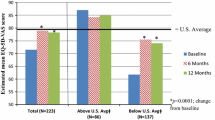Abstract
Health-related quality of life was assessed in a diet and exercise intervention study among 157 healthy men aged 35–60 years (mean ± s.d.; 46.2 ± 5.0) with moderately raised cardiovascular risk factors. The men were randomized to four groups, diet (D, n=40), exercise (E, n=39), diet plus exercise (DE, n=39), and no active intervention (controls (C) n=39). Quality of life was measured with two self-administered questionnaires; Subjective Symptoms Assessment Profile and Minor Symptom Evaluation Profile, at baseline and after 1.5, 3 and 6 months. Cardiovascular risk factors were investigated at baseline and after 6 months. As a result of changes in dietary habits and physical exercise in the three intervention groups, several important cardiovascular risk factors were significantly reduced. The quality of life/well-being did not differ between the four groups and did not change significantly in any of the groups during the study. There was, however, a tendency towards fewer gastrointestinal symptoms in group D and fewer cardiac symptoms in group DE. We conclude that advice on lifestyle changes in the form of diet and exercise reduce risk factors in middle-aged men without negative effects on their quality of life.
Similar content being viewed by others
References
DimenäsE, ÖstergrenJ, LindvallK, DahlöfC, WestergrenG, deFaireU. Comparison of CNS-related subjective symptoms in hypertensive patients treated with either a new controlled release (CR/ZOK) formulation of metoprolol or atenolol. J Clin Pharmacol 1990; 30: S82-S90.
OsI, BratlandB, DahlöfB, GisholtK, SyvertsenJO, TretliS. Lisinopril or nifedipine in essential hypertension? A Norweigan multicenter study of efficacy, tolerability and quality of life in 828 patients. J Hypertension 1991; 9: 1097–1104.
PalmerAJ, FletcherAE, RudgePJ, AndrewsCD, CallaghanTS, BulpittCJ. Quality of life in hypertensives treated with atenolol or Captopril: a double-blind crossover trials. J Hypertension 1992; 10: 1409–1416.
TestaMA, AndersonRB, NackleyJF, HollenbergNK, Quality of Life Hypertension Group. Quality of life and antihypertensive therapy in men. A comparison of captopril with Enalapril. N Engl J Med 1993; 328: 907–913.
Åberg H. Life quality in non-pharmacological therapy of hypertension. Scand J Primary Health Care 1990; Suppl. 1: 61–66.
GranB. Non-pharmacological methods reduce drug use in the treatment of hypertension. Scand J Primary Health Care 1991; 9: 121–128.
The Treatment of Mild Hypertension Research Group. The treatment of mild hypertension study. A randomized, placebo-controlled trial of a nutritional-hygenic regimen along with various drug monotherapies. Arch Intern Med 1991; 151: 1413–1423.
The Expert Panel of the National Cholesterol Education Program, Report of the National Cholesterol Education Program Expert Panel on detection, evaluation, and treatment of high blood cholesterol in adults. Arch Intern Med 1988; 148: 36–69.
WHO. Diet, Nutrition and the Prevention of Chronic Diseases. Report of a WHO Study Group. WHO Technical Report Series 797. Geneva. World Health Organization 1990.
European Atherosclerosis Society. Prevention of coronary heart disease: Scientific background and new clinical guidelines. Recommendations of the European Atherosclerosis Society prepared by the International Force for Prevention of Coronary Heart Disease. Nutr Metab Cardiovasc Dis 1992: 2: 113–156.
WHO. Comprehensive Cardiovascular Community Control Programmes in Europe. EURO Reports and Studies 106. Copenhagen, World Health Organization, Regional Office for Europe 1988.
Wiklund I. Measuring quality of life in medicine. Scand J Primary Health Care 1990; Suppl. 1: 11–14.
AndersonRT, AaronsonNK, WilkinD. Critical review of the international assessments of health-related quality of life. Qual Life Res 1993; 2: 369–395.
NaughtonMJ, WiklundI. A critical review of dimension-specific measures of health-related quality of life in cross-cultural research. Qual Life Res 1993; 2: 397–432.
HelléniusML, deFaireU, BerglundB, HamstenA, KrakauI. Diet and exercise are equally effective in reducing risk for cardiovascular disease. Results of a randomized controlled study in men with slightly to moderately raised cardiovascular risk factors. Atherosclerosis 1993; 103: 81–91.
HelléniusML, deFaireU, KrakauI, BerglundB. Prevention of cardiovascular disease within the primary health care system—feasibility of a prevention programme within the Sollentuna primary health care catchment area. Scand J Primary Health Care 1993; 11: 68–73.
Becker W. The Swedish household survey 1989. Presented at the sixth European nutrition Conference 1991, Athens, Greece. Abstract in Nutritional Science, New Developments of Consumer Concern.
BorgG. Perceived exertion as an indicator of somatic stress. Scand J Rehab Med 1970; 2–3: 92–98.
DahlöfC, DimenäsE, OlofssonB. Documentation of an instrument for assessment of subjective CNS-related symptoms during cardiovascular therapy. Cardiovasc Drugs Ther 1989; 3: 919–927.
Dahlöf C. Minor Symptoms Evaluation (MSE) Profile—a questionnaire for assessment of subjective CNS-related symptoms. Scand J Primary Health Care 1990; Suppl. 1: 19–25.
Dimenäs E. The SSA-profile, an instrument for assessment of subjective symptoms among hypertensives. Scand J Primary Health Care 1990; Suppl. 1: 27–30.
DimenäsE, WiklundI, DahlöfC, LindvallKG, OlofssonBK, deFaireU. Differences in the subjective well-being and symptoms of normotensives, borderline hypertensives and hypertensives. J Hypertension 1989; 7: 885–890.
Schlettwein-GsellD. Nutrition and the quality of life: a measure for the outcome of nutritional intervention? Am J Clin Nutr 1992; 55: 1263S-1266S.
Arborelius E. How to affect patients lifestyle? The-oretical and practical implications. Soc Sci Med, 1994.
HjermannI, HolmeI, LerenP. Oslo Study Diet and Antismoking Trial. Am J Med 1986; 80: 7–11.
HjermannI, ByreKV, HolmeI, LerenP. Effect of diet and smoking intervention on the incidence of coronary heart disease. Report from the Oslo study group of a randomised trial in healthy men. Lancet 1981; ii: 1304–1310.
ErikssonKF, LindgärdeF. Prevention of type 2 noninsulin-dependent diabetes mellitus by diet and physical exercise. Diabetologia 1991; 34: 891–898.
SiscovickDS, WeissNS, FletcherRH, LaskyT. The incidence of primary cardiac arrest during vigorous exercise. N Engl J Med 1984; 311: 874–877.
MittlemanMA, MaclureM, ToflerGH, SherwoodJB, GoldbergRJ, MullerJE. Triggering of acute myocardial infarction by heavy physical exertion. Protection against triggering by regular exertion. N Engl J Med 1993; 329: 1677–1683.
WillichSN, LewisM, LöwelH, ArntzHR, SchubertF, SchröderR. Physical exertion as a trigger of acute myocardial infarction. N Engl J Med 1993; 329: 1684–1690.
CurfmanGD. Is exercise beneficial—or hazardous—to your heart? N Engl J Med 1993; 329: 1730–1731.
FriedewaldVE, SpenceDW. Sudden cardiac arrest associated with exercise: The risk-benefit issue. Am J Cardiol 1990; 66: 183–188.
GordonNF, ScottCB. The role of exercise in the primary and secondary prevention of coronary artery disease. Clin Sports Med 1991; 10: 87–103.
Author information
Authors and Affiliations
Additional information
This study was supported by grants from the Swedish Heart-Lung Foundation, the Knut and Alice Wallenberg Foundation, the Karolinska Institute Foundation, and the Bayer Fellowship for general practitiones.
Rights and permissions
About this article
Cite this article
Hellénius, ML., Dahlöf, C., Åberg, H. et al. Quality of life is not negatively affected by diet and exercise intervention in healthy men with cardiovascular risk factors. Qual Life Res 4, 13–20 (1995). https://doi.org/10.1007/BF00434378
Received:
Accepted:
Issue Date:
DOI: https://doi.org/10.1007/BF00434378




